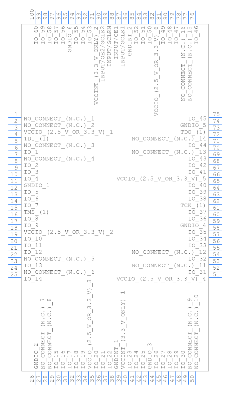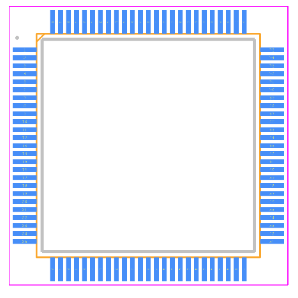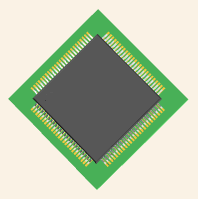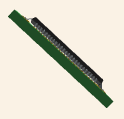EPM7064AETC100-10N CPLD: Features, Applications and Datasheet
2024-09-24 14:55:47 1377
EPM7064AETC100-10N Description
The EPM7064AETC100-10N is a CPLD (Complex Programmable Logic Device) from Intel / Altera's EPM7064AE family. It has 1250 gates and supports supply voltages ranging from 3 V to 3.6 V. The chip is packaged in a TQFP-100 package and features a 64-cell macrocell count, 4 Logic Array Blocks (LABs), a maximum operating frequency of 222.2 MHz, a propagation delay maximum of 4.5 ns, and 68 inputs/outputs (I/Os). It is also RoHS compliant and is of the EEPROM memory type.
EPM7064AETC100-10N Features
The EPM7064AETC100-10N is a CPLD (Complex Programmable Logic Device) with a variety of remarkable features. It supports an operating voltage of up to 100 volts and an operating current of 114 amps with a resistance value of 5 ohms, which makes it excellent for handling high loads and complex logic. In addition, the chip has a wide operating temperature range from -55 degrees to 175 degrees, making it ideal for operating in extreme environments, such as automotive electronic control systems.
In terms of performance, the EPM7064AETC100-10N has a large cell count of 64 and 4 Logic Array Blocks (LABs), a maximum operating frequency of up to 222.2 MHz, and a maximum propagation delay of 4.5 ns, parameters that ensure efficient data processing and fast response times. It also provides 68 inputs/outputs (I/Os) for easy connection and communication with other electronic components.
Of particular note, the EPM7064AETC100-10N excels in automotive applications. Not only does it provide efficient power conversion and overcurrent protection, it also helps to improve the safety and reliability of automotive electronic control systems. This is critical for modern automobiles, as automotive electronic systems are becoming increasingly complex and demand higher levels of safety and reliability.
In summary, the EPM7064AETC100-10N has become one of the chips of choice for many electronics engineers with its excellent performance and wide range of applications.
EPM7064AETC100-10N Applications
The EPM7064AETC100-10N, Intel's CPLD (Complex Programmable Logic Device), has a wide variety of applications. First of all, it performs particularly well in automotive applications, providing efficient power conversion and overcurrent protection, which are essential for improving the safety and reliability of automotive electronic control systems.
In addition, the EPM7064AETC100-10N is suitable for other areas where high reliability and efficiency are required. Its high-performance parameters, such as a large cell count of 64, 4 Logic Array Blocks (LABs), a maximum operating frequency of 222.2 MHz, and a low propagation delay (4.5 ns maximum), make it capable of meeting the needs of a wide range of complex logic controls.
Therefore, the EPM7064AETC100-10N is not only limited to automotive applications, but can also be widely used in communications, industrial control, consumer electronics and many other fields, providing powerful logic control capability and reliable performance guarantee for these fields.
EPM7064AETC100-10N Alternatives
EPM7064AETC100-10
EPM7064AETC100-10N CAD Model
Symbol

Footprint

3D Model



EPM7064AETC100-10N Manufacturer
Intel, known as Intel Corporation, has become one of the leaders in the semiconductor industry since it was founded in 1968 by Robert Noyce and Gordon Moore, among others. Initially known for its production of memory chips, the company successfully transformed itself into a producer of microprocessors and has achieved excellence in this field, becoming one of the largest semiconductor companies in the world.
Intel's main products are microprocessors (CPUs), which act as the heart of computers and are responsible for performing a wide range of complex computing tasks. In addition, Intel is also involved in a variety of fields such as solid state drives, chipsets, and networking equipment, providing high-performance semiconductor solutions to users around the world.
In terms of market position, Intel occupies an important position globally by virtue of its advanced technology and strong brand influence. Its products are widely used in many fields such as personal computers, servers, data centers, etc., providing solid support for the development of the digital world.
EPM7064AETC100-10N FAQ
Q: What type of chip is the EPM7064AETC100-10N?
A: The EPM7064AETC100-10N is a Complex Programmable Logic Device (CPLD) manufactured by Intel/Altera and belongs to the MAX 7000A family.
Q: What are the key features of the EPM7064AETC100-10N?
A: The EPM7064AETC100-10N has a large cell count of 64, 4 Logic Array Blocks (LABs), a maximum operating frequency of up to 222.2 MHz, a maximum propagation delay of 4.5 ns, support for a 3.3V operating supply voltage, and 68 inputs/outputs (I/Os).
Q: What applications is the EPM7064AETC100-10N used in?
A: The EPM7064AETC100-10N is widely used in automotive electronic control systems, communication equipment, industrial control systems, and consumer electronics due to its high performance and reliability.
Q: What is the package form of EPM7064AETC100-10N?
A: The EPM7064AETC100-10N is packaged in a TQFP-100 package, which is easy to integrate and install and is suitable for a variety of board designs.
Q: If the EPM7064AETC100-10N is discontinued, what alternatives are available?
A: If the EPM7064AETC100-10N is discontinued, similar CPLD chips from the same series or from other manufacturers can be considered as alternatives. The specific selection needs to be based on a comprehensive evaluation of the specific needs of the project and the performance parameters of the alternatives. For example, the EPM7064AETC100-10 (note that model numbers may vary slightly) may be one of the potential alternatives, but be sure to consult the latest product manuals and datasheets for accurate information.




